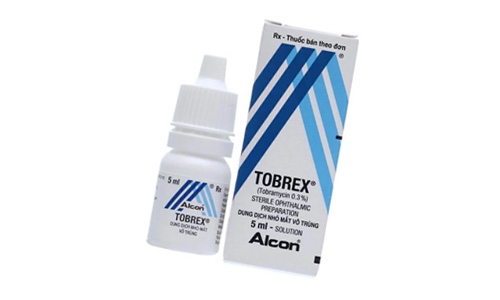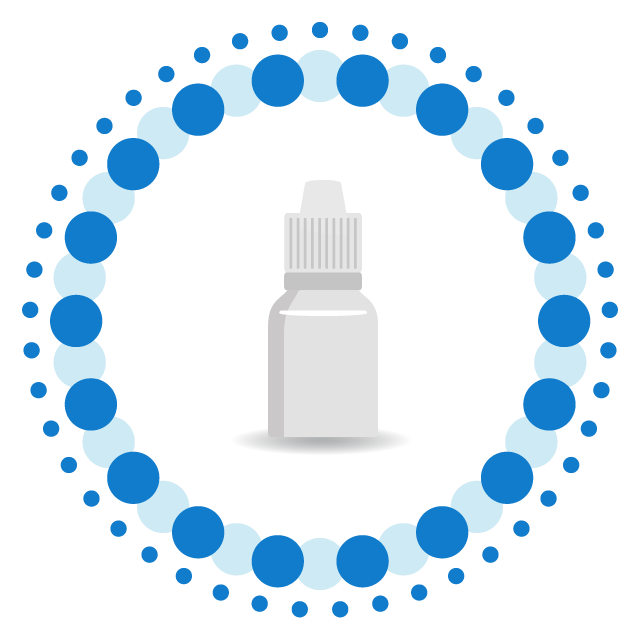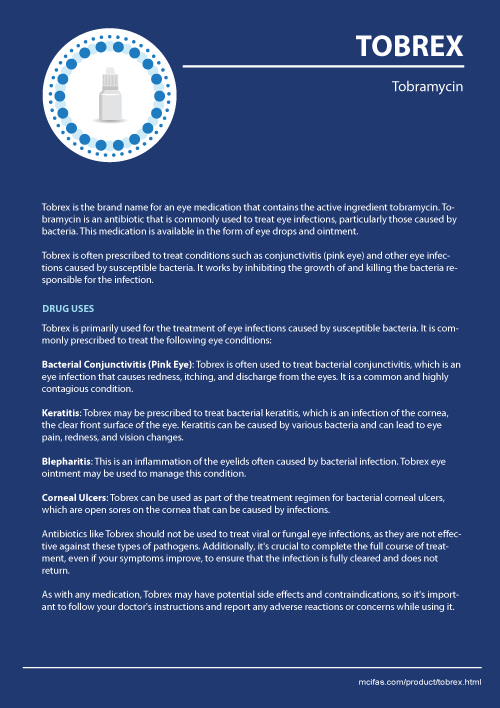Tobrex Prescribing Information
Tobrex is the brand name for an eye medication that contains the active ingredient tobramycin. Tobramycin is an antibiotic that is commonly used to treat eye infections, particularly those caused by bacteria. This medication is available in the form of eye drops and ointment.
Eye drops is often prescribed to treat conditions such as conjunctivitis (pink eye) and other eye infections caused by susceptible bacteria. It works by inhibiting the growth of and killing the bacteria responsible for the infection.

Uses of Tobrex
Tobrex is primarily used for the treatment of eye infections caused by susceptible bacteria. It is commonly prescribed to treat the following eye conditions:
- Bacterial Conjunctivitis (Pink Eye): Tobrex is often used to treat bacterial conjunctivitis, which is an eye infection that causes redness, itching, and discharge from the eyes. It is a common and highly contagious condition.
- Keratitis: Tobrex may be prescribed to treat bacterial keratitis, which is an infection of the cornea, the clear front surface of the eye. Keratitis can be caused by various bacteria and can lead to eye pain, redness, and vision changes.
- Blepharitis: This is an inflammation of the eyelids often caused by bacterial infection. Tobrex eye ointment may be used to manage this condition.
- Corneal Ulcers: Tobrex can be used as part of the treatment regimen for bacterial corneal ulcers, which are open sores on the cornea that can be caused by infections.
Antibiotics should not be used to treat viral or fungal eye infections, as they are not effective against these types of pathogens. Additionally, it's crucial to complete the full course of treatment, even if your symptoms improve, to ensure that the infection is fully cleared and does not return.
As with any medication, Tobrex may have potential side effects and contraindications, so it's important to follow your doctor's instructions and report any adverse reactions or concerns while using it.
Dosage
The appropriate dosage of Tobrex can vary depending on the specific eye infection being treated and the individual patient's age and medical condition. Do not use more or less of the medication than prescribed.
Typically, Tobrex eye drops are administered as follows:
For adults and children (including infants):
- For Bacterial Conjunctivitis: The usual dose is one to two drops into the affected eye(s) every 4 to 6 hours. Treatment may continue for 7 to 10 days.
- For Other Eye Infections: The dosing schedule may vary depending on the severity of the infection.
When using Tobrex eye ointment, a small strip of ointment is usually applied to the inside of the lower eyelid of the affected eye(s) 2 to 3 times a day, or as directed by your doctor.
It's crucial to wash your hands before applying the eye drops or ointment and avoid touching the tip of the dropper or the tube to prevent contamination. If you are using other eye medications, there should be a time gap between administering different eye drops or ointments to allow each medication to work effectively.
Side Effects of Tobrex
Tobrex is generally well-tolerated when used as directed, but like all medications, it can have side effects. Not everyone will experience these side effects, and they can vary in severity. Common side effects may include:
- Temporary Eye Irritation: Some individuals may experience a mild, temporary burning or stinging sensation in the eyes after using Tobrex eye drops.
- Eye Redness: Redness of the eyes can occur in some cases, usually as a temporary reaction to the medication.
- Blurry Vision: Blurred vision may occur after applying Tobrex eye ointment or drops. This effect is usually temporary and should not last long.
- Itching or Swelling: Itching, swelling, or other signs of irritation around the eyes may occur in some individuals.
- Watery Eyes: Excessive tearing or watery eyes can be a side effect for some people.
These side effects are generally mild and tend to improve as your eyes become accustomed to the medication.
It's important to note that while uncommon, Tobrex can potentially cause more serious side effects, such as:
- Allergic Reactions: Rarely, some people may experience an allergic reaction to Tobrex, which can include symptoms like rash, itching, swelling, severe dizziness, or difficulty breathing. If you experience any of these symptoms, seek immediate medical attention.
- Eye Pain or Discomfort: If you experience severe eye pain, changes in vision, or any other unusual or severe eye symptoms, you should contact your doctor immediately.
- Superinfection: Prolonged use of antibiotics like Tobrex can sometimes lead to overgrowth of non-susceptible bacteria or fungi, which may require additional treatment.
- Hypersensitivity Reaction: In rare cases, the use of Tobrex can cause a hypersensitivity reaction that may manifest as skin rashes, fever, or other systemic symptoms.
Interaction with other drugs
Tobrex is an antibiotic eye medication, and when used as directed, it typically has limited interactions with other drugs. Since it is applied directly to the eye, its systemic absorption is minimal, which reduces the potential for drug interactions compared to oral or injectable medications. However, it's still essential to be aware of possible interactions. Here are some considerations:
- Other Eye Medications: When using Tobrex in conjunction with other eye medications (e.g., eye drops, ointments), it's important to space out the application to prevent dilution and interference with the effectiveness of either medication.
- Systemic Aminoglycosides: Tobramycin is an aminoglycoside antibiotic. If you are taking other systemic aminoglycoside antibiotics (e.g., amikacin, gentamicin) for another medical condition, there is a potential for additive toxicity.
- Neuromuscular Blocking Agents: Tobramycin, when used systemically at high doses, can enhance the effects of neuromuscular blocking agents (e.g., vecuronium, pancuronium), which are used during surgery. When Tobrex is applied to the eyes, the systemic absorption is low, so the risk of interactions with neuromuscular blocking agents is minimal. However, it's a good practice to inform your surgeon or anesthesiologist if you have recently used Tobrex before surgery.
- Diuretics: Some diuretics (water pills), such as furosemide, may increase the risk of ototoxicity (hearing and balance problems) when used with aminoglycoside antibiotics like Tobramycin. However, this risk is mainly associated with systemic administration, not the topical use of Tobrex.
- Corticosteroids: Combining Tobrex with corticosteroid eye drops or ointments may be prescribed in certain cases to manage inflammation along with the infection.
What to avoid while on Tobrex
When using Tobrex eye drops or ointment to treat an eye infection, there are certain precautions and things to avoid to ensure the medication's effectiveness and your overall eye health:
- Contact Lenses: Avoid wearing contact lenses while you have an eye infection and are using Tobrex. Contact lenses can introduce bacteria into your eyes and may also interfere with the proper absorption of the medication. Consult your eye doctor about when it is safe to resume wearing contact lenses.
- Touching Your Eyes: Avoid touching your eyes with your fingers, especially if your hands are not clean. This can introduce additional bacteria and potentially worsen the infection. Always wash your hands thoroughly before and after applying Tobrex.
- Sharing Eye Medications: Do not share your Tobrex eye drops or ointment with others, even if they have similar symptoms. Eye infections can be caused by different types of bacteria, and using someone else's medication may not be appropriate or effective.
- Makeup and Eye Cosmetics: It's advisable to avoid using eye makeup and cosmetics on or around the affected eye(s) while you have an eye infection. These products can introduce contaminants and irritants. You can resume using makeup once your eye infection has cleared, but make sure your cosmetics are clean and not expired.
- Eye Irritants: Try to avoid exposure to smoke, dust, and other irritants that can exacerbate your eye condition. If you need protection, consider wearing glasses or sunglasses.
- Allergic Reactions: Allergic reactions can be severe and require immediate medical attention.
- Driving and Operating Machinery: Tobrex eye drops or ointment may cause temporary blurriness or other vision changes after application. If you experience such effects, it is advisable to avoid activities such as driving or operating heavy machinery until your vision has cleared.
Contraindications of Tobrex
Tobrex is generally considered safe and effective for treating certain eye infections caused by susceptible bacteria. However, there are specific contraindications and situations where the use of Tobrex may not be appropriate. Contraindications are conditions or circumstances in which the use of a particular medication is not recommended due to the potential for harm. Here are some contraindications:
- Allergy or Hypersensitivity: Medicine should not be used if you have a known allergy or hypersensitivity to tobramycin or any other aminoglycoside antibiotics. Allergic reactions can be severe and even life-threatening.
- Fungal or Viral Eye Infections: Tobrex is an antibiotic designed to treat bacterial eye infections. It is not effective against fungal or viral eye infections, such as those caused by fungi, herpes viruses, or adenoviruses. Using Tobrex in these cases would not provide any benefit and may delay appropriate treatment.
- Tympanic Membrane (Ear Drum) Perforation: Tobrex is intended for use in the eyes and should not be used in the ear. It should not be applied to the ear if there is a perforation (hole) in the tympanic membrane.
- Neuromuscular Disorders: Although the risk is generally minimal with topical eye use, people with certain neuromuscular disorders, such as myasthenia gravis, may be more sensitive to the effects of aminoglycoside antibiotics like tobramycin.
- Children: The dosing and duration of treatment may be adjusted based on the child's age and weight.
- Liver or Kidney Dysfunction: Tobrex is primarily eliminated by the kidneys. People with severe kidney dysfunction may need dose adjustments, but this is more relevant for systemic use of tobramycin rather than topical use in the eyes.
» Drug Uses (format pdf, 0.2 Mb)



